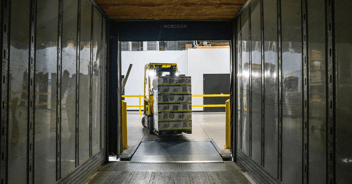
There are two models of which many businesses store and operate based upon. These are just-in-time (JIT) and just-in-case (JIC). These two models determine how products and stock are ordered, stored and prepared for distribution. There are many benefits and drawbacks to either model, and in this blog we will explore each one and explain the ideal use of each model for a business operating with a 3PL.
Just In Time
A Just in time storage and operations model operates on the basis that only the stock or product needed is stored and prepared for distribution. This model is largely used by businesses that have consistent trends that they can base predictions on. It is also a beneficial model to use for products with a short shelf life that needs to be moved frequently.
Benefits of a Just in Time Model
Lower Warehouse Cost
Due to the lower number of products being stored at a warehouse, it is cheaper to operate with a just-in-time model. As you are only storing and moving the exact amount of product you will be selling or distributing elsewhere, the amount of storage needed is clear. This allows for easier pricing from a warehouse or 3PL company as you will be taking up a smaller footprint in their location.
Efficiency
Efficiency is another benefit of a just-in-time model. Since the correct amount of product is ordered each time, there are drastically fewer products to categorize and organize. This allows for a far more efficient operation as fewer resources are needed to be dedicated to moving and storing the product.
Price
The costs associated with JIT storage are significantly cheaper than JIC. This is because the amount of product ordered and stored is a lot less than a JIC model. Since you are only ordering what you need and paying for storage based on trends, your costs remain around the same.
Decreased waste
Another larger benefit of a JIT model is the decreased shorts and waste. As almost the exact amount of product is prepared and stored, the amount of leftover products or products capable of expiring is almost nothing. This saves you money and allows a less wasteful operation.
Prevent Over-Ordering
As the whole premise of JIT is to only order and store as close to the required amount as possible, over-ordering is unlikely.
Drawbacks
While there are many benefits to working with a JIT model, there are several disadvantages that come with the restricted ordering and storing process. While these disadvantages are not a deal-breaker for every business, they may be relevant for yours.
Demand surge
If your business or a certain product faces a sudden surge in demand that is not accounted for, you are prone to losing out on large amounts of revenue and even losing customers to a business that can meet demand. Because JIT models are based on having just the right amount of product in stock at the right time, when a surge in demand occurs, you are unable to meet the demand with the amount you have in stock.
Disruptions
In a similar situation to surges in demand, if a disruption should occur and your quantity of stock is limited, you face the risk of not being able to get existing orders and products out to customers. As there is no reserve stock, either by nature of the product or due to strictly following a JIT model if a major disruption occurs you may be unable to fulfill orders.
Missed Opportunities
As with any business that only plans for correct amounts, you are likely to miss new opportunities that wish to purchase or place orders outside of your stored or prepared amount. For example, if you have already sent all of the projected products to your 3PL for them to store and distribute on your behalf, and suddenly a customer wishes to double their order; you may be unable to meet this demand and increase in revenue as you have allocated all of your available product with no reserves.
Just In Time Ideal Uses
Just in time business models are ideal for businesses who have forecasted quantities of products going out based on previous trends. When working with a 3PL, this can be done by sending the exact amount of product required for all of your customers, to the facility in preparation for the 3PL to take over. Since a 3PL would charge you for any extra space you take up in their warehouse and trucks, it is an ideal model to use to reduce costs and get the most out of your partnership.
Just In Case
A just-in-case storage and operation model operates in the fashion of over-preparing whilst meeting the demand of customers. This model is largely used by companies who produce large amounts of popular items that either have an extended shelf life or are known to be popular with customers. Since this model operated on the basis that having more is better than not enough, it can be pricier than a JIT model. By ensuring that a surplus of products is available to your 3PL, you can ensure there will always be a product available.
Benefits of a Just In Case Model
Fewer backorders
Due to a planned surplus of products, it is less likely that backorders and out-of-stock situations will occur. When working with a 3PL, you would send your projected order amounts and then some to be stored and distributed. Where this differs from a JIT model is that while the minimum amount for fulfilling orders is available, there is essentially a backup of product to be used in case of issues with ordering and more product than forecasted is needed.
Less damage from disruption
Another area where a JIT model can be beneficial is during disruptions along the supply chain. Since more product has been made available from the start to your 3PL or own distributors, when disruptions such as shorts, damages, misdeliveries and more occur, there is a plentiful number of products to replace or be redirected.
Product Backups
Accidents happen during all stages of the distribution process. That is why it is key to have contingency plans and products to ensure all orders can be fulfilled. The biggest difference between a JIT and a JIC model here is that with a JIT model, there is a significantly smaller product backup available for any accidents. Since only a forecasted amount is sent out from the manufacturer, if a product is damaged at any point of its journey, a replacement is hard to come by without extra expenses. Whereas with a JIC, the surplus of product is readily available to cover these mistakes.
Respond to market changes
With changing market conditions comes uncertainty. Should a customer wish to order double their usual amount due to a shift in the market, a JIC model can accommodate that with little to no effect on the supply.
Low Maintenance
Another huge benefit of a JIC model is its lower levels to maintain supply numbers. When working in a JIT model, the forecasted number of products must be coordinated and sent to a 3PL or your distributor each cycle. This means more work for someone. Whereas with a JIC model, you supply the forecasted amount plus extras which allows for the 3PL or in-house distributor to work through the surplus of product before having to bring more in. This can work especially well when the 3PL you work with utilizes powerful OMS and IMS software to correctly catalog the number of products and order more automatically.
Drawbacks
Increased storage costs
Likely the largest drawback of a JIC model is the elevated costs of storing the surplus product, especially when utilizing a 3PL. While your forecasted product will move through the stages and the cost will be the same as a JIT model. Any product not going out for distribution and that is purely just in case, will be charged as it is taking up their warehouse space. This can be especially costly when your surplus stays at a standstill.
Expiry and obsolete product
Coinciding with the increased storage prices is the risk of products becoming obsolete, or expiring before they get a chance to move. While it is beneficial to have a backup of products, especially if they are susceptible to damage, products such as food have an expiry and the surplus product may expire before it gets any use. This can be a drastic loss of money when you consider that you have paid higher storage costs on a product that can not make you money. The other risk with JIC models are products becoming obsolete. If you were to store a large amount of a certain product to have a backup and be prepared for a surge, but then the product becomes obsolete, then you are stuck paying the storage fees on the product, or have to consider it as a loss and dispose of the product. Either way, you have lost money on the product by overstocking.
Just In Case Ideal Uses
A Just In Case model is ideal for a business that knows they have a product they can move. Alongside this, their products usually benefit from extended shelf life. If working with a 3PL, it is beneficial to know if your products are guaranteed to move, or if the storage rates are reasonable. This will reduce the costs of storing your surplus while still allowing you to be prepared for disruptions.
Which Is the Best Model?
For companies looking to operate and move their goods with a 3PL, a combination of the two models is ideal. Incorporating a balance of smaller batches of forecasted sales of goods, but maintaining a moderate surplus to account for disruptions guarantees your business can operate with fewer bumps.
Birkby Works to Help Your Just in Case or Just in Time Business
Birkby offers state-of-the-art technology, flexibility, and over 100 years in the industry. When you choose Birkby as your 3PL partner, you experience our dedication and commitment to helping you, firsthand. We work with you to find a warehousing or 3PL solution that best fits your storage and operations model. Whether it is just in time, or just in case, trust Birkby to get you results.
Looking for a 3PL or Warehouse Provider?
Contact us today to learn more about Birkby’s comprehensive 3PL and warehousing solutions.





Leave a Comment